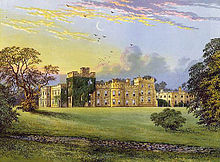Hornby Castle (North Yorkshire)
Hornby Castle is a fortified manor house on the edge of Wensleydale between Bedale and Leyburn in English administrative unit North Yorkshire . English Heritage has listed it as a Grade I Historic Building.
The house originally dates from the 14th century, but was rebuilt in the 15th, 18th and 20th centuries. It was built from ground sandstone rubble and covered with slate . The current building is the south wing of a larger complex, the rest of which has been demolished.
history
At the end of the 14th century Hornby Castle belonged to the St. Quintin '' until the heiress Margaret Quintin married a John Conyers († 1422).
In the 15th century, William Conyers, 1st Baron Conyers , had the castle largely rebuilt, but the St. Quintins tower from the 14th century, which was named after the previous owners and was only demolished in 1927, was retained. After the death of John Conyers, 3rd Baron Conyers , the property fell to his daughter Elizabeth , who married John Darcy . It was passed on in the Darcy family, who became Earls of Holderness in 1682 , until Robert Darcy, 4th Earl of Holderness , who died in 1778. Conyers Darcy, 2nd Earl of Holderness , was elected Member of Parliament for Boroughbridge in 1660 and Member of the Yorkshire Parliament in 1661 .
During the English Civil War , Hornby Castle was taken by parliamentary troops under Ralph Assheton , who did not carry out the order to razor the fortified house . The house was built in the 1760s by architect John Carr of York fundamentally rebuilt. The south wing and the east wing (demolished in the 1930s), as well as various outbuildings, are thanks to him. He worked on behalf of the 4th Earl of Holderness.
The 4th Earl's daughter and heiress, Amelia, Baroness Darcy and Baroness Conyers , married Francis Osborne, Marquess of Carmarthen , who later became the 5th Duke of Leeds . At Hornby Castle he collected fine 18th century furniture from various houses, which are depicted in Percy Macquoid's books . After Amelia's death in 1784, the property fell to her son, George Osborne, 6th Duke of Leeds (1775-1838). After Kiveton Park was demolished in 1811, Hornby Castle became the headquarters of the Dukes of Leeds up to George Osborne, 9th Duke of Leeds .
In 1889 the property belonged to a Colonel Foster and in 1929 to a Sir Harold Parkinson . In 1930 the property was split up and most of the house was demolished. A 16th century doorway has been preserved in the Burrell Collection in Glasgow .
The remaining property, on which the south wing of the house still stood, was acquired by Major General Walter E. Clutterbuck in 1936 and bequeathed it to Roger Clutterbuck and his wife Julia . They turned the park into a pasture where they keep a small herd of bison . As a private house, the manor is not open to the public.
Individual evidence
- ^ Hornby Castle, Hornby, North Yorkshire . British Listed Buildings. Retrieved November 23, 2015.
- ^ Bibliography Hornby Castle, Yorkshire . Gatehouse Gazetteer. Retrieved November 23, 2015.
- ↑ DARCY, Hon. Conyers (1622-92), of Hornby Castle, Yorks. . History of Parliament Online. Retrieved November 23, 2015.
- ^ Osborne family, Dukes of Leeds . The National Archives. Retrieved November 23, 2015.
- ↑ Hornby Castle . British Towns and Villages Network. Retrieved November 23, 2015.
swell
- Howard Colvin: A Biographical Dictionary of British Architects 1600-1840 . 3. Edition. Yale University Press, New Haven 1995: "John Carr"
Web links
Coordinates: 54 ° 20 ′ 20.4 " N , 1 ° 39 ′ 10.8" W.

